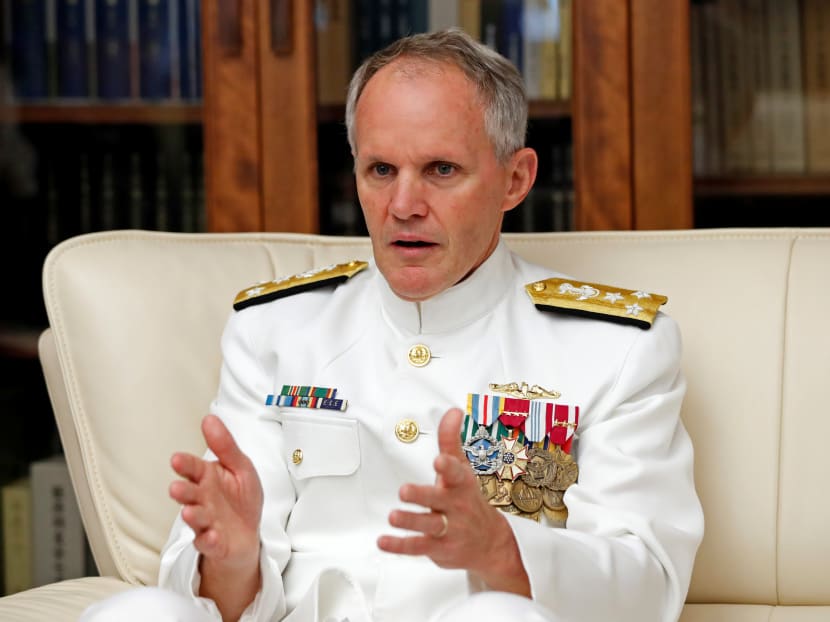Following spate of collisions, US navy may introduce new measures for warships entering busy ports like S’pore
SINGAPORE — The United States Navy may introduce additional measures for its warships entering busy ports like Singapore, the new commander of the US 7th Fleet said on Friday (Oct 13), nearly two months after a fatal collision between the USS John S McCain missile destroyer and an oil tanker in the Republic’s territorial waters.

Vice Admiral Sawyer assumed his new role two days after the collision of USS John S McCain near Singapore. Photo: Reuters
SINGAPORE — The United States Navy may introduce additional measures for its warships entering busy ports like Singapore, the new commander of the US 7th Fleet said on Friday (Oct 13), nearly two months after a fatal collision between the USS John S McCain missile destroyer and an oil tanker in the Republic’s territorial waters.
The collision on August 21 killed 10 US sailors, and came on the back of a string of collisions involving US warships in the Pacific. The incident also raised questions about how ships navigated busy waterways like those near Singapore.
When asked about this on Friday at his first media interview as the 7th Fleet commander, Vice Admiral Phillip Sawyer hinted that the US navy was considering new measures. But he declined to give details, citing ongoing investigations into the incident and a review into the recent crashes involving US warships.
“As we look closely at the investigation and understand what could have been done differently, it’s very likely that we may place some other measures into effect,” Vice Admiral Sawyer told reporters at PSA Sembawang.
He added: “At this point, it’s premature for me to speculate on that…I want to make sure that I fully understand what the investigators come up with – the issues, the causes – before we start putting corrective action into place.”
Vice Admiral Sawyer, who assumed his role two days after the collision near Singapore, is here on a five-day trip to meet the Republic’s leaders and top military officers. He is also visiting US Navy personnel on the littoral combat ship USS Coronado, which is in Singapore for routine maintenance before resuming its rotational deployment in South- and South-east Asia.
The Aug 21 collision has puzzled experts, who questioned why the warship, which was at the time making its way to Singapore for a routine visit, failed to avoid the crash with the tanker.
Singapore’s Transport Safety Investigation Bureau (TSIB) said in September that both vessels were detected on the radar, but the authorities did not receive the US warship’s Automatic Identification System (AIS) signal that most vessels are required to broadcast to provide information about their whereabouts.
Military vessels typically carry the system, but often turn it off because the captains do not want to reveal so much information.
Investigations into the collision could take up to 12 months to complete, and the full findings will be made public once ready, said the TSIB, which is working closely with the United States Coast Guard and the Liberian authorities on the probe.
The USS John S McCain collision was the second such deadly accident in two months, after a US destroyer collided with a cargo ship in June, and the fourth accident involving an American warship in the Pacific this year.
In the June incident, another US destroyer, the Fitzgerald, collided with a cargo ship off Japan.
US Navy chief of naval operations Admiral John Richardson had announced a comprehensive Navy-wide review of ship operations, following the collision in Singapore waters. The results of that review are expected to be announced in a few weeks.
Giving his take on the preliminary findings of the investigation, Vice Admiral Sawyer said that operational demands on the 7th Fleet were so high that sailors did not prepare and train enough.
“I think over time, the balance shifted too much to the operational side, and not enough to making sure that our teams were rested and trained and go do the things we were asking them to do. That shift now, I recognise it, and I gotta get the balance back to normal,” he added.
Earlier this week, the US Navy said the collision involving USS John S McCain was preventable, and relieved the warship’s commander and executive officer for poor judgement and leadership.
Turning to the US Navy’s ties with Singapore, Vice Admiral Sawyer said both navies have had a “good, warm, robust dialogue” about future engagements.
Pacific Griffin, which was the US and Singapore’s first bilateral naval exercise off the waters of Guam in late August, is a good example of how “our relationship and collaboration have increased over the years”, he noted.
“I think the friendship is good. We very strongly value the strategic partner that is Singapore, and I think, from my discussions with the Singapore Navy, that they value what we bring to the table. We look to continue doing that moving forward,” Vice Admiral Sawyer added.








